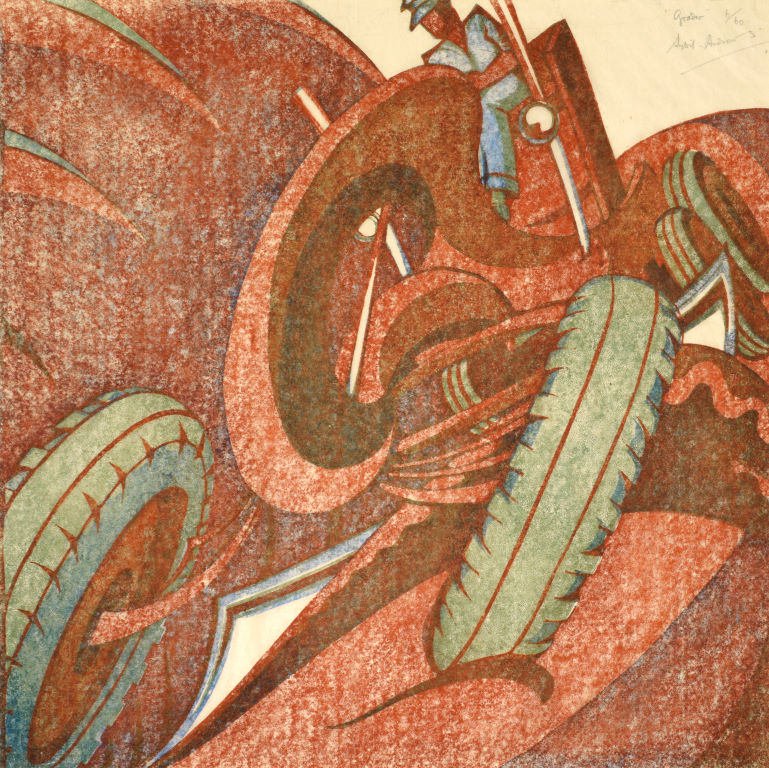Thursday 14 February 2013
Julia Waite
Before we left for the summer holidays a colleague invited me downstairs to view a recently acquired artwork. In the crypt-like Receiving Room we watched registrar Fiona Moorhead unwrap Sybil Andrews’ Grader, 1959.
I’d spent some time studying an image of the linocut on my PC, and the real thing didn’t disappoint. Rolling its way down the tissue-like paper, which is so transparent you can be looking at the reverse of the print without realising it, is the carefully cut image of a piece of mid-century farm machinery full of force and dynamism. Grader exudes energy and charm in part because of Andrews’ management of bold subject matter in a tight composition, and her use of the somewhat homely and accessible linocut technique.

Sybil Andrews, Grader, 1959
linocut, Auckland Art Gallery Toi o Tāmaki, purchased 2012
Representing the rhythms of contemporary life in tightly composed scenes of the city, sport and work, Andrews was a master of her modern medium – the linoleum block print. Made using industrial flooring material, lino prints were considered a lesser art form than wood cut prints. But Claude Flight, leader of the Grosvenor School, rejected the restraints of the past and ignored entrenched hierarchies, declaring that ‘a lino-cut colour print should not look like an oil or water-colour painting, it is a print from a soft linoleum block and should not be taken for a wood-cut, a wood engraving, or an etching, it should take its individual place on a wall and be recognised as a lino-cut’.
In Grader the white blade slices the ground, cutting a curly ribbon of earth as the large front wheels go one way, and the smaller rear wheels another. In the midst of this swirl of curvilinear forms and angles man and machine appear fused, and it’s difficult to establish who’s in control. This was very likely an effect Andrews was eager to create. The faceless, lone worker in Grader contrasts Andrews’ earlier scenes of manual labour in which workers come in teams, appearing more abstract – a reflection of her egalitarian interests which she shared with the fellow Grosvenor School linocutters.
Described as ‘British Futurists’, the Grosvenor School linocutters incorporated elements from other styles, like the Italian Futurists celebratory depictions of speed and movement – what Umberto Boccioni feverishly described as ‘our whirling life of steel, of pride, of fever and of speed’. There are also links with what the Vorticists described in Blast as ‘the forms of machinery, factories, new and vaster buildings, bridges and works’. Though most of the Grosvenor School’s scenes of the city and inter-war merriment appear less imbued by pervading unease compared with the Vorticist’s visions of a sinister and dehumanising city.
Andrews produced many of the Grosvenor School’s most enduring images of the 1920s and 30s, including Haulers, 1929 and The Gale, 1930 (both held in Auckland Art Gallery). In Speedway, 1934, we see her suggestion of a more threatening and impersonal machine age, one that might fuse human and machine.
At the height of the linocut movement Andrews used the speed of the city as a metaphor for the modern world. But in 1947 she moved to Canada, and settled in Campbell River, a remote logging and fishing town on Vancouver Island, British Columbia. Although she found herself in an isolated area (more Douglas Fir forests than speedways), Andrews was still able to find local scenes of activity – logging trucks and ploughers at work, ice skaters at play, and these became sources of inspiration for her art. The titles of her works – Logging Team, 1952, Hauling, 1952, Skater, 1953, Ploughing Pasture, 1954 – hint at an on-going interest in movement and manual work.
Auckland Art Gallery holds 12 other works by Sybil Andrews, all of which were gifted to the Gallery by Rex Nan Kivell in 1953, along with more than 200 other British modernist prints. And while the Gallery has some of the best examples of Andrews’ work, until we acquired Grader we had nothing to represent her later career.